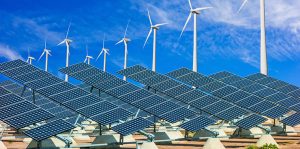
All of those wind farms in Oklahoma helped increase the amount of planned new electric-generating capacity from wind, solar and battery storage in the U.S. this year.
The U.S. Energy Information Administration reports the three technologies account of 825 of the new, utility-scale generating capacity that developers plan to bring online in the nation.
Wind, solar, and battery storage are growing as a share of new electric-generating capacity each year. In 2023, these three technologies account for 82% of the new, utility-scale generating capacity that developers plan to bring online in the United States, according to the EIA’s Preliminary Monthly Electric Generator Inventory.
Utility-scale solar capacity didn’t start ramping up in the United States until 2010. As the cost of solar panels dropped substantially and state and federal policies introduced generous tax incentives, solar capacity boomed. As of January 2023, 73.5 gigawatts (GW) of utility-scale solar capacity was operating in the United States, about 6% of the U.S. total.
Just over half of the new U.S. generating capacity expected in 2023 is solar power. If all of the planned capacity comes online this year as expected, it will be the most U.S. solar capacity added in a single year and the first year that more than half of U.S. capacity additions are solar.
Prior to 2000, U.S. wind capacity was negligible. Similar to solar power, tax incentives, lower turbine construction costs, and new renewable energy targets helped fuel the growth of U.S. wind capacity. As of January 2023, 141.3 GW of wind capacity was operating in the United States, about 12% of the U.S. total. Developers plan to add another 7.1 GW in 2023.
The majority of U.S. wind capacity is located in the blustery, central part of the country, which also offers wide-open prairies that can accommodate large wind farms. Offshore wind farms along the country’s coastline offer significant potential for future wind capacity growth. This year, developers are planning one new offshore wind farm.
Wind and solar are intermittent sources of generation; they only produce electricity when the wind is blowing or the sun is shining. Because batteries can store electricity from wind and solar generators for later use, battery storage systems are increasingly installed with wind and solar projects. In 2023, developers plan to add 8.6 GW of battery storage power capacity to the grid, which would double total U.S. battery power capacity.
Although significant renewable capacity has been added in the past decade, differences in the amount of electricity that different types of power plants can produce mean that wind and solar made up about 17% of the country’s utility-scale capacity in 2021 but produced only 12% of our electricity.
Source : EIA report





